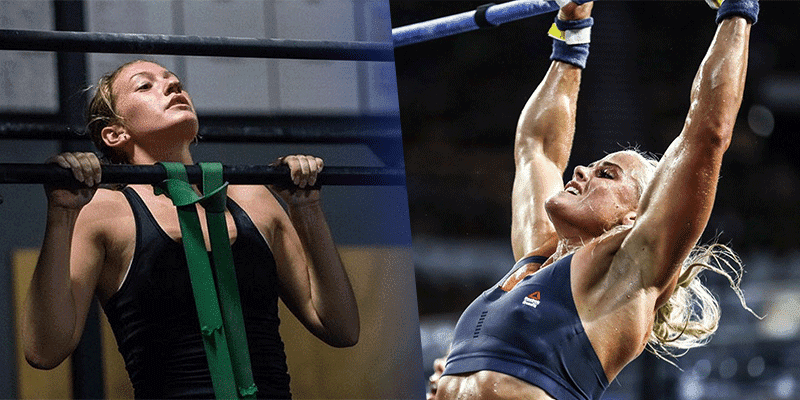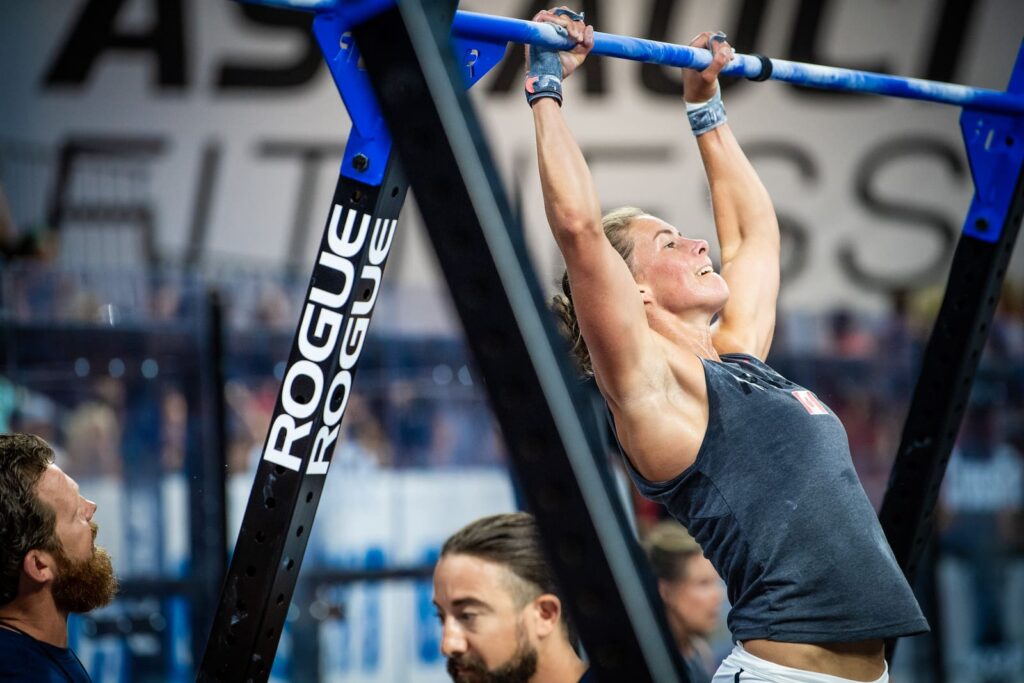Pull up vs chin up, how should you use each one in your training?
What’s the Difference between a chin up and a pull up?
Chin ups and pull ups are two different exercises, but they’re both bodyweight pulling movements.
The difference between chin ups and pull ups is the grip you use to perform each one.
Pull up utilise a wider grip than chin ups, so your hands will be farther apart when you perform a pull-up exercise in comparison with a chin-up.
 Source: Photo courtesy of CrossFit Inc
Source: Photo courtesy of CrossFit IncChin up grips are supinated while pull-up grips are pronated.
- Supinated means you grip the bar with an underhand grip.
- Pronated means you grip the bar with an overhand grip.
The terms “pronated” and “supinated” refer to which direction the palms of our hands face while gripping an object such as an Olympic barbell in order to work out with them.
Pull Up vs Chin Up: Which is Better?
Pull ups are great for the back, but chin ups hit your biceps and lats better.
Chin ups are easier to learn than pull ups because they use less strength and more technique.
Pull ups require more strength and can be difficult at first if you’re not used to it.
Pull Up Vs Chin Up: What Muscles do Pull Ups Work?
Pull ups are an upper body strength exercise.
Pull ups work your upper back, lats and biceps. You can also target your core muscles when doing pullups. The muscles in your lower back, shoulders and forearms also get worked by doing pullups as well as the chest, triceps and trapezius muscle groups.
What Muscles do Chin Ups Work?
- Chin ups work the biceps, brachialis and forearms.
- Chin ups work the lats, rhomboids and middle trapezius.
The chin up is an upper body pulling exercise that uses your own body weight to challenge you.
It is an alternative to doing pull ups on a bar, which is difficult for many people due to shoulder flexibility issues or strength deficits in their back muscles (in this case they would be better off doing weighted pull downs).
The chin up puts less stress on the shoulders than a pull up, but more stress than a lat pull down.
 Source: Photo courtesy of CrossFit Inc.
Source: Photo courtesy of CrossFit Inc.Pull Up vs Chin Up: How to do a Pull Up
Pull ups are a great exercise for overall back strength and development. They work your lats (latissimus dorsi), biceps, and forearms, as well as your core muscles to support your body weight.
Pull up bars are usually placed at the top of the doorframe or wall, making it easy to take a break when you need it.
While doing pull ups is an excellent way to get started with working out at home, there are several variations on this exercise that can help you challenge yourself or even make pull ups more effective. Here’s a quick guide on how to do a pull up correctly:
- Grip the bar with palms facing away from you
- Hang from the bar
- Inhale and brace your core and grip
- Contract the lats and brace your upper body to start the movement
- Keep your body straight throughout the entire movement
- Pull yourself up until your chin goes above the bar (or just below if this is too difficult)
- Pause, then slowly lower yourself to the starting position
- Exhale
Pull Up vs Chin Up: How to do a Chin Up
A chin-up is a straightforward exercise that requires no equipment (apart from the bar) and can be completed anywhere — you don’t need a gym membership to do it.
The key to doing a chin-up correctly is to grip the bar with your palms facing towards you, hang from the bar with arms extended and legs slightly bent, pull yourself up until your chin is over the bar, lower yourself back down to starting position, then repeat for required number of reps.
If you’re new to this type of exercise (and even if you’re not), start by hanging from an overhead bar using just one arm at a time for as long as possible before switching arms. Then move onto two-arm hangs for 30 seconds at a time before swapping back to one arm again. This will help prepare your body for heavier lifts later on down the road!
Pull Up Variations
- Wide Grip
- Alternating Grip (pronated, then supinated)
- Kipping Pull Ups
- One Arm Pullup
- Weighted Pullups (with weighted vest)
- Band-Assisted Pull Up
Chin Up Variations
There are several different variations of chin ups, including:
Close grip chin up – the bar is closer to your body than with a normal chin up. This makes it easier to use pull your body up. It also puts more stress on the biceps as well as making it harder for the back muscles to engage throughout the pull-up motion.
A close grip can be done using either one or two hands on a bar or rope, depending on equipment availability and preference.
Which are Better for Beginners?
Chin ups are easier than pull ups, but they do use your biceps more.
Pull ups are better for upper back strength and endurance, while chin ups are better for biceps.
Beginners should focus on chin ups first, then move onto pull up variations once they’re comfortable with the movement.
Because of their difficulty level, beginners shouldn’t attempt to do a weighted pull up or chin up until they can easily perform multiple sets of 10-12 bodyweight reps in good form.
They’re Similar, but not the Same
Although they’re similar, chin ups and pull ups are not the same exercise. They differ in several ways:
- Chin ups are easier than pull ups because you use your biceps to squeeze your arms together at the top of a chin up and thereby shorten their range of motion. Pull ups require more strength from your lats to lift your body weight as well as flexion of your elbows (which is necessary for a full range of motion).
- Chin ups work the biceps a bit more than pull ups do, whereas pull ups involve greater recruitment from the lats (the muscles along either side of your spine).
- Pullups are harder than Chin Ups because they require a longer range of motion—basically back and forth between full extension (arms completely straight) and full flexion (arms at 90 degrees with palms facing away from you). In contrast, during one complete repetition on a chin-up bar or machine your arms go through only half this range; they start bent at 90 degrees but end up almost straightened out over time due to gravity pulling down on them!